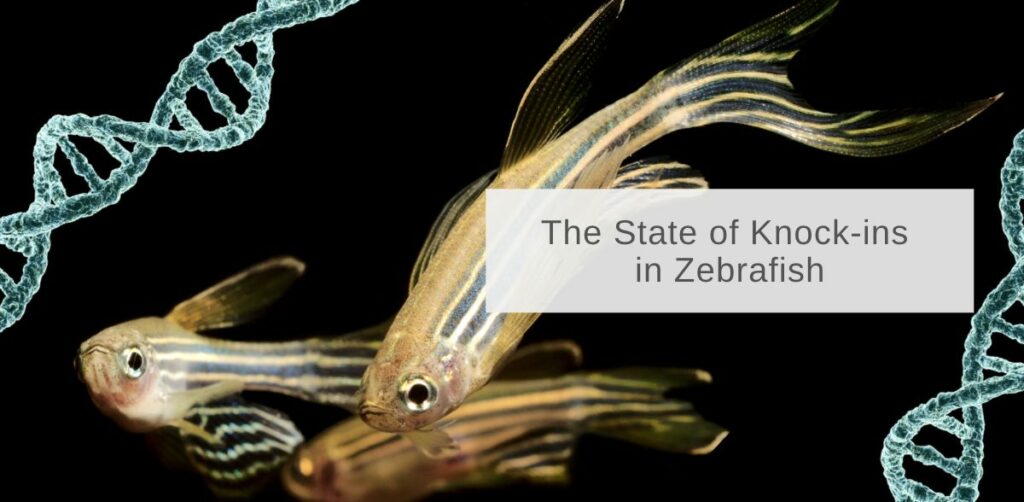Summary
- Knock-ins enable testing of a gene’s function through introducing precise mutations or attaching tags.
- Creating knock-ins in zebrafish presents it own unique challenges due in large part to the balance between competing mechanisms of DNA repair.
- Improvements in the success of edits can be achieved through checking cutting efficiency and optimizing the type of donor DNA template.

Introduction
The recent advancements of CRISPR and next-generation technology has enabled researchers to create more precise zebrafish models of human disease. Even with the transformative improvements in the ease of genome editing, however, knock-in (KI) techniques in zebrafish still present unique challenges. In this post we discuss the current state of CRISPR-Cas9-mediated targeted knock-ins in zebrafish, and what the future holds.
The Challenges of Knocking-In
CRISPR-based gene editing works by using a guide RNA to direct a Cas9 nuclease to cut a specific site in the genome, which is then repaired by different pathways to achieve different types of edits. Originally applied to making knock-outs (KOs)–inactivating a gene by deleting a small fragment–CRISPR’s capability has expanded to include the generation of knock-ins in which genetic material is inserted into the cut site. The application of CRISPR techniques to zebrafish has enabled big gains within biomedical and disease research, however, achieving site-specific zebrafish knock-ins is still challenging. This can be attributed to two main factors: the competing repair mechanisms of non homologous end joining (NHEJ) and homology directed repair (HDR), and imperfect prediction tools for zebrafish models.
The greater difficulty of achieving successful knock-ins versus knock-outs has been compared to home construction, with knock-ins being considered more difficult since “building something is harder than tearing it down.” Whereas a knockout is generated when DNA repair leaves an assortment of insertions or deletions (INDELs) that disrupt gene function, a knock-in requires precise placement of a cargo DNA within the cut site. However, the differences between these two techniques are a little more complicated than that to differences in the repair pathways that the two techniques rely on: whereas knockouts utilize NHEJ or MMEJ repair pathways which are the most active in the cell, knock-ins require homology-directed repair (HDR). Some model organisms like yeast have fortuitously greater HDR activity that aids in generating knock-ins. Zebrafish knock-ins encounter the same challenge as in most model organisms of encouraging precise HDR repair and while avoiding the messier NHEJ repair.
Success Starts with Cutting Efficiency
A common thread that runs through most successful zebrafish knock-ins is sgRNAs that cut with high efficiency. Using tools to predict sgRNA cutting efficiency is an essential first step for any CRISPR editing project. After all, you have to have an efficient cut before you can generate repair from a template! Unfortunately, the prediction tools we have are still evolving and are based on input data that may need expansion and updating. In our own labs, we have found that predictors are still imperfect: in a recent survey where we compared the predicted cutting efficiency from two popular algorithms to our own in vivo measured efficiencies, we found little evidence of correlation. Therefore, we recommend first testing the cutting efficiency of sgRNAs experimentally before proceeding with a knock-in.
Optimizing to Favor HDR
Even after a cut is achieved, there is at present no reliable predictor for whether HDR will occur at a genomic locus. Evolving tools and methods are making progress towards favoring HDR and insertion of desired DNA at the target site. The form of donor homology DNA–either ssDNA, dsDNA, or plasmid DNA–can have an impact on the fidelity of HDR insertion, but you might have to try different forms to determine which yields the best results for your locus. For some genes, placing cut sites within introns insulates the target knock-in from the effects of imperfect repair. With the multiple parameters that can be adjusted to help drive HDR and efficient edits, the field has yet to converge on a unified formula for successful knock-ins.
Conclusion
At InVivo Biosystems we have dedicated many operational and protocol improvements to developing more effective techniques for zebrafish knock-in creation, and are now approaching an 80% success rate at knocking in small (several nucleotides) to medium sized (up to several hundred nucleotides) templates. Knocking in larger insertions such as fluorophores remains a challenge for all of us in the field. We see the value in undertaking knock-in projects, as any one protein tag or reporter line can be the key to a breakthrough, and we are here to help. Observing recent progress, we are optimistic that current research is trending towards making gene knock-in technology more attuned towards the zebrafish community, opening up more avenues of study.
References
Albadri, S., Del Bene, F., & Revenu, C. (2017). Genome editing using CRISPR/Cas9-based knock-in approaches in zebrafish. Methods (San Diego, Calif.), 121-122, 77-85. https://doi.org/10.1016/j.ymeth.2017.03.005
Choi, TY., Choi, TI., Lee, YR. et al. (2021). Zebrafish as an animal model for biomedical research. Exp Mol Med 53, 310-317 https://doi.org/10.1038/s12276-021-00571-5
Howe, K., Clark, M., Torroja, C. et al. (2013). The zebrafish reference genome sequence and its relationship to the human genome. Nature 496, 498-503 https://doi.org/10.1038/nature12111
Moreno-Mateos, M. A., Vejnar, C. E., Beaudoin, J. D., Fernandez, J. P., Mis, E. K., Khokha, M. K., & Giraldez, A. J. (2015). CRISPRscan: designing highly efficient sgRNAs for CRISPR-Cas9 targeting in vivo. Nature methods, 12(10), 982-988. https://doi.org/10.1038/nmeth.3543
Prill, K. and Dawson, J. F., (2020) Homology-Directed Repair in Zebrafish: Witchcraft and Wizardry? Front Mol Biosci. 2020; 7: 595474 https://www.frontiersin.org/articles/10.3389/fmolb.2020.595474/full



